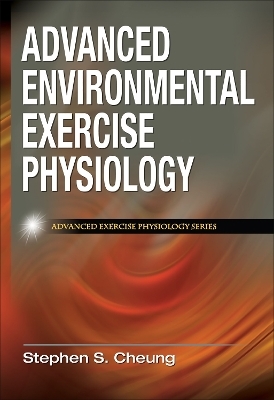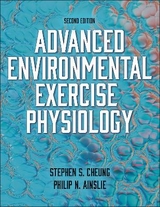
Advanced Environmental Exercise Physiology
Human Kinetics (Verlag)
978-0-7360-7468-1 (ISBN)
- Titel erscheint in neuer Auflage
- Artikel merken
Students entering advanced study of environmental physiology may have little experience in researching environmental physiology or may not realize the depth and breadth of the field. Advanced Environmental Exercise Physiology offers the first complete look at the scope and major ideas of environmental exercise physiology. It provides students with a solid grounding in prominent research topics and a thorough understanding of the key concepts and current debates in the field.
Using an integrative approach, Advanced Environmental Exercise Physiology, the first book in Human Kinetics’ Advanced Exercise Physiology series, considers the human capacity to exercise in and tolerate various environments. Readers will examine the major impact of each environment explored, and they will discover areas of current debate to stimulate further research. The text also helps students directly link the research to athletic and occupational situations in various environments.
Through Advanced Environmental Exercise Physiology, students will learn the following:
• The initial physiological responses upon exposure to an environment that a person is not adapted to
• How the body adapts to repeated exposure to an environment
• How various environments affect the ability to exercise and work
• Individual variability in response to stressful environments
Readers will also gain a firm knowledge of the application of basic exercise physiology to specific environmental stressors by looking at the countermeasures that people can take to minimize the impact of environmental stressors. Among the issues explored in this text are the effects of heat, hydration, and cold in the thermal environment; diving, altitude training, and other pressure effects on the human system; and the influences tthat pollution and air quality have on exercise. The text also explores the microgravity (space) environment and chronobiological rhythms and their effects on exercise performance.
Advanced Environmental Exercise Physiology addresses the primary environmental factors affecting people when they are exercising and competing in sport, and it provides evidence-based information with numerous references. By linking research with recommendations for real-world situations, this text serves as an invaluable resource for students and professionals alike.
Human Kinetics’ Advanced Exercise Physiology series offers books for advanced undergraduate and graduate students as well as professionals in exercise science and kinesiology. These books highlight the complex interaction of the various systems both at rest and during exercise. Each text in this series offers a clear and concise explanation of the system and details how each is affected by acute exercise and chronic exercise training.
Stephen S. Cheung, PhD, is the Canada research chair in environmental ergonomics in the department of physical education and kinesiology at Brock University in St. Catharines, Ontario. Dr. Cheung has published more than 45 papers in topics that span the chapters in this book, including extensive publication on hyperthermia and its effect on exercise capacity and fatigue as well as the effects of cold on manual function and marine survival. Dr. Cheung is a member of many professional organizations, including the Canadian Society for Exercise Physiology, the American College of Sports Medicine, and the Aerospace Medical Association. He serves on the executive committee of the International Conference on Environmental Ergonomics, and he graduated with honors from the prestigious International Space University in Barcelona. He received his PhD in exercise science from the University of Toronto. In his leisure time, Dr. Cheung enjoys bicycling and racing, playing squash, and reading.
Chapter 1. Overview of Environmental Physiology
Interdisciplinary Design Issues
Common Terminology in Environmental Physiology
Common Research Themes
Summary
Chapter 2. Fundamentals of Temperature Regulation
Heat Balance Equation and Factors Affecting Heat Exchange
Models of Thermoregulatory Control
Thermal Stress Scales
Summary
Chapter 3. Heat Stress
Direct Effects of Hyperthermia
Pace Selection With Hyperthermia
Individual Variability in Heat Tolerance
Cooling Strategies
Summary
Chapter 4. Hydration Strategies for Exercise
Physiology of Fluid Balance
Developing a Hydration Strategy
Summary
Chapter 5. Cold Air Exposure
Manual Function in the Cold
Cold Injuries to the Extremities
Physiological Responses to Exercise in the Cold
Summary
Chapter 6. Cold Water Immersion
Sudden Immersion and Cold Shock
Muscle Failure in the Cold
Hypothermia
Post-Rescue Collapse
Summary
Chapter 7. Diving and Hyperbaric Physiology
The Physics of Diving
Respiratory Responses to a Hyperbaric Environment
Barotrauma
Decompression Sickness
Inert Gas Narcosis
Saturation Diving
Summary
Chapter 8. Training and Performing at Moderate Altitude
Models of Physiological Responses to Hypoxic Stimulus
Genetic Basis of Altitude Performance
Live Low, Train High
Live High, Train High
Live High, Train Low
Hyperoxia
Considerations in Applying Altitude Training
Summary
Chapter 9. Mountaineering and High Altitude Physiology
Physiological Responses to High and Extreme Altitudes
High Altitude Illnesses
Summary
Chapter 10. Microgravity and Spaceflight
The Microgravity Environment
Physiological Responses to Microgravity
Exercise Countermeasures
Extravehicular Activity Physiology
Spacesuit Design
Radiation Exposure
Summary
Chapter 11. Exercise in Polluted Environments
Air Quality Indices
Ozone Effects on Health and Exercise
Managing Air Pollution for Athletes
Summary
Chapter 12.Chronobiological Rhythms and Exercise Performance
Sleep–Wake Cycle Basics
Circadian Pattern in Exercise Capacity
Sleep Deprivation
Shift Work
Jet Lag
Summary
Afterword
Appendix
References
About the Author
| Reihe/Serie | Advanced Exercise Physiology |
|---|---|
| Verlagsort | Champaign, IL |
| Sprache | englisch |
| Maße | 178 x 254 mm |
| Gewicht | 748 g |
| Themenwelt | Studium ► 1. Studienabschnitt (Vorklinik) ► Physiologie |
| Naturwissenschaften ► Biologie ► Humanbiologie | |
| ISBN-10 | 0-7360-7468-6 / 0736074686 |
| ISBN-13 | 978-0-7360-7468-1 / 9780736074681 |
| Zustand | Neuware |
| Haben Sie eine Frage zum Produkt? |
aus dem Bereich



